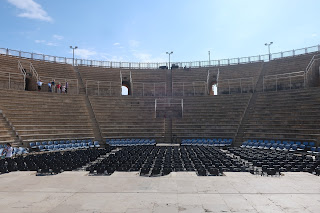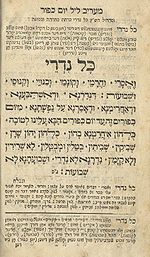So many of the Jewish holidays are solemn in nature -- they serve to remind us annually of challenges the Jews have faced and how, fortunately, the challenges were overcome. Some of the holidays that don't fall into this category, like Rosh Hashanah and Yom Kippur, are still solemn -- we think about the past year and atone for the wrongs that we've done.
Simchat Torah (שמחת תורה, literally "joy of the Torah") is an exception. It's an incredibly festive day when we celebrate the end of the Torah cycle and start anew with the first sentences of Genesis. There is dancing, drinking (in synagogue, during the service), singing, and much merriment.
The evening service has a few prayers but focuses on seven hakafot (הקפות, circumambulations). All of the Torah scrolls are taken out of the ark and groups of people are called up to participate in each of the הקפות. Our congregation called children (and parents and grandparents) up by age: birth to kindergarten, 1st grade, 2nd and 3rd grade, 4th and 5th grade, 6th and 7th grade, 8th and 9th grade, and anyone who didn't participate. Alice and Gabi jointly carried one of the scrolls while marching in a slow circle.
After the service, all of the kids were given goodie bags, filled with candy. Needless to say, our kids were happy.
The morning service is pretty similar, although less crowded. Jan and I arrived in time for a couple of prayers and the start of the הקפות. This time, the age groups were different: 75+, 65-75, 55-65, 45-55, 35-45, 25-35, and under 25. Smaller crowds meant more opportunity to carry the Torah and we both relished that chance. The other fun part of the morning service was that the drink cart -- water, juice, wine, whiskey -- was in the room and people just kept filling glasses.
But Simchat Torah is not just about dancing with the Torah. It's about finishing the annual reading of the Torah and starting again right away. Everyone in the room was called up as part of one of the aliyot. The cantor read the last chapter of Deuteronomy before we opened up another Torah and he read started with Genesis.
Simchat Torah is also about rain. There is a special prayer after the Torah service that asks God to send rain to help water the crops. So, to the title of the blog post, as the rabbi is leading the prayer, someone actually pulled out a spray bottle and watered him. Sadly, Helen wasn't present to pull the trigger.
After all of this, the celebrating wasn't over. On Monday night, there is something called הקפות שניה (hakafot shneeyha, the second hakafot). It's a public celebration, taking place in a main public square in Ra'anana (think something about half the size of Tappan Square in Oberlin). Each of the הקפות is about 20 minutes -- it started at 9pm (or so) and was probably going to run for 3 hours. Words can't do it justice so I'll just post some pictures and videos for you to enjoy.
The mayor of Ra'anana and the swing band.
Not sure what this is -- a dancing buddy?
This is our rabbi and members of our congregation.
These celebrations happen across the country. What makes this so special for us is that Ra'anana is the only city where there is mixed dancing and our congregation is the only one that is allowed to have men and women dancing together. Everywhere else, the men dance together and there is another, smaller area for the women to dance. I don't know if they're allowed to dance with a Torah though...














































